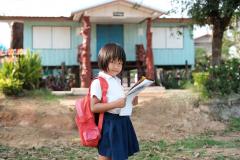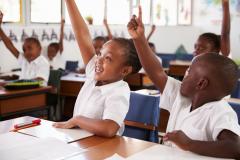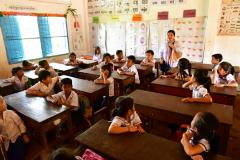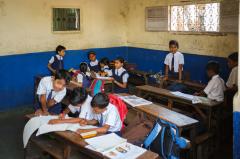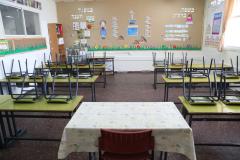In low-resourced and post-conflict settings, textbooks are the main, and often the only, learning materials available to teachers and students. In many subject areas, textbooks serve as the de facto curriculum as well as the default daily lesson plan. In stable, well-resourced education systems, a wide array of materials and connectivity options in and out of school can foster SEL and promote most Target 4.7 themes. However, many under-resourced systems must deal with over-sized and crowded classes, poor reading and comprehension skills (often due to learning in a second language), teachers who are insufficiently-prepared and supported and often driven to promote rote learning for high stakes examinations. Such conditions are an obstacle to promoting SEL and achieving ‘a huge shift in mindset1 to ‘people and planet’ themes, such as gender, social inclusion, and environmental sustainability by 2030.
The push in recent decades to provide every child with a textbook, and widespread support for revising textbooks to cover 21st -century skills, suggests one potentially powerful strategy that may be feasible even in many difficult context—namely, embedding more content and pedagogy around ‘people and planet’-related behaviour change in textbooks and other education materials.2 Textbook revision is already included in many national education plans and funding for textbooks exists in national or household-level budgets. Target 4.7 themes and SEL are particularly well-suited to language, social studies, and science subjects as well as to supplementary materials for early grades reading and accelerated learning or adult education. However, many textbook writers and developers—typically university faculty, curriculum specialists and/or experienced teachers—may have limited knowledge of sustainability issues, including Target 4.7 themes, or of SEL as the basis for behaviour change. Moreover, urban-based writers often know little of the challenging conditions in rural classrooms or how emerging ‘people and planet’’ issues might be contextualized to be relevant, motivational and impactful to the current generation of girls and boys in rural and peri-urban areas.
These immense challenges can only be addressed through conscious and targeted training and continuing support for local writers of textbooks and other educational materials designed for national education systems. At this level, all teachers, youth and other stakeholders should be engaged in needs assessments and content development to ensure appropriate contextualisation, relevance and practicality. Core textbooks must integrate locally developed, pedagogically structured, and motivational versions of SEL and its application to Target 4.7 themes. They should provide teachers with easy-to-follow pedagogical techniques for engaging students, even where resources are limited and classes are overcrowded. Finally, the new content should be embedded in all required and nationally assessed subjects. Curriculum and writing teams for textbooks should liaise with national examination authorities to ensure the Target 4.7 content and related skills are systematically incorporated into student examinations and assessments. The presence of these topics in national examinations will ensure that teachers and students pay attention to them.
1 “Few instruments shape children’s and young people’s minds more powerfully than the teaching and learning materials used in schools. Textbooks convey not only knowledge but also social values and political identities, and an understanding of history and the world. Teachers and students trust textbooks as authoritative and objective sources of information, assuming that they are accurate, balanced and based on the latest scientific findings and pedagogical practice.” UNESCO. (2016). Textbooks pave the way to sustainable development. Global Education Monitoring Report: Policy Paper. Paris: UNESCO. 28. December. 19. Retrieved from: http://unesdoc.unesco.org/images/0024/002467/246777E.pdf.
2 UNESCO Mahatma Gandhi Institute of Education for Peace and Sustainable Development (UNESCO MGIEP). (2017). Textbooks for Sustainable Development: A guide to embedding New Delhi: UNESCO MGIEP. 186. Retrieved from: http://unesdoc.unesco.org/images/0025/002599/259932e.pdf
RECOMMENDATION 3 (a): Consult with teachers, youth, community leaders, examination boards and other stakeholders, together with local writers to assess needs and to ensure that textbook content is appropriately contextualised.
RECOMMENDATION 3 (b): Introduce and train textbook developers, including writers, editors, and illustrators, to Target 4.7 themes and SEL topics and how these themes and topics support each other. This training should also focus on how to ensure that these themes and topics reflect local capacities and priorities, resources, pedagogy and language skills.
RECOMMENDATION 3 (c): Provide ongoing support to monitor and guide the inclusion of these topics as writers develop new educational materials. Draw on existing international guides to ensure that textbook illustrations promote gender equality and social inclusion.
RECOMMENDATION 3 (d): Bring together writers and subject specialists at national examination boards to ensure that Target 4.7 themes are meaningfully reflected in national assessments and examinations.

